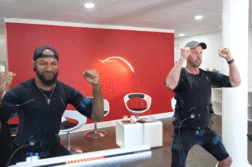St. Louis, MO. (Ivanhoe Newswire)– We all know eating right and exercising are key to staying healthy. But can flexing our creative muscles help us thrive as we age? Research from the national institute on aging suggests participating in the arts may improve not only our physical well-being, but our mental health, as well. And now, one woman is getting the elderly off their recliners and into ballet class. with ageless exercise.
This is not your typical ballet class… Fran Hu lets Ivanhoe news know this by saying, “I’m the first in my family to reach 90.”
Hu and her friends are busy learning points and plies (plee-a’s) in a ballet class made just for them.
Vanessa Woods, the Vitality in Motion owner and founder, explains that “The benefits of it are for everyone.”
Woods, a classically trained professional ballerina, wanted seniors to experience the way dancing made her feel physically and emotionally, “It’s not jolting movement, it’s smooth and sustained and graceful.”
With the help of physical and occupational therapists, woods created vitality in motion. Whether done standing or sitting, at a barre or in the water, students here say they notice a difference.
“It’s an art to start with and generally speaking, true ballet has good music.” Martha, who is 82 years old, says.
Lavern, 81-years-old, adds, “This is just a way to keep the body in shape.”
Mary Elizabeth, also 81-years-old says, “It’s different, than the typical exercise, but it does make it interesting.”
Studies show, older adults who participate in dance experience improvements in balance and memory. An NIH study links dance with improving cognitive function. Woods says everyone can benefit from the ballet basics, most importantly, “Find a time in your day to do some movement, even if it’s just extending your foot out into the air or your wrist, and just gently moving some just gentle range of motion movements are so beneficial.” Woods wants everyone to realize, it’s never too late to learn and to love to dance.
The physical benefits of dance on aging bodies is well-established but a study out of Massachusetts General in Boston found the joy and social connections formed in a weekly dance class improves energy and mental outlook. Ten years after vitality in motion began, it now hosts about 300 classes per month. The oldest student is 107 years old. You can join virtual classes by logging on to vitality-in-motion-dot-com.
Sources:
https://www.nia.nih.gov/news/participating-arts-creates-paths-healthy-aging
https://www.nia.nih.gov/news/participating-arts-creates-paths-healthy-aging
https://www.massgeneral.org/psychiatry/news/study-dancing-boosts-fitness-and-mood-of-older-adults
Contributor(s) to this news report include: Marsha Lewis, Producer; Roque Correa, Videographer and Editor.
To receive a free weekly email on Smart Living from Ivanhoe, sign up at: http://www.ivanhoe.com/ftk



